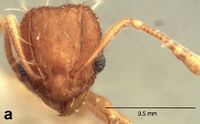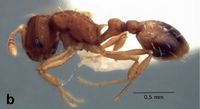Wasmannia longiseta
| Wasmannia longiseta | |
|---|---|

| |
| Scientific classification | |
| Kingdom: | Animalia |
| Phylum: | Arthropoda |
| Class: | Insecta |
| Order: | Hymenoptera |
| Family: | Formicidae |
| Subfamily: | Myrmicinae |
| Tribe: | Attini |
| Genus: | Wasmannia |
| Species: | W. longiseta |
| Binomial name | |
| Wasmannia longiseta Cuezzo & Calcaterra, 2015 | |
This species is known only from secondary forest habitats of the Chaco and Paranaense phytogeographical provinces (Cabrera & Willink, 1980) present in Formosa, Corrientes, and Misiones provinces in northeastern Argentina and probably in Paraguay. A similar species was found by Alex Wild (Wasmannia alw02) in Amambay, Canindeyú, Concepción, and Ñeembucú (Paraguay). All these collecting sites represent a continuous occurrence area centered on 25ºS and 57ºW and located in the ecotone between the Chaco and Atlantic Forest ecoregions. More surveys are necessary to determine in which of these two ecoregions it is more common. (Cuezzo et al. 2015)
Identification
Cuezzo et al. (2015) - worker This species is recognized by the following combination of characters: 1) head in dorsal view reticulate; 2) Malar space and postgena also reticulate without longitudinal carina as in other spp. of Wasmannia, and 3) gaster smooth and shiny, with abundant long (>1 mm), curved and whitish setae.
No other species of Wasmannia shows the particular set of characters described in the diagnosis. This species is morphologically similar to Wasmannia affinis and Wasmannia lutzi in several aspects (cephalic sculpture and general shape of the petiole), but differs in the number of setae in the vertexal margin, which is fewer in W. affinis and W. lutzi. These two species have a petiolar peduncle shorter than the length of the petiole in lateral view.
Keys including this Species
Distribution
Distribution based on Regional Taxon Lists
Neotropical Region: Argentina (type locality).
Distribution based on AntMaps
Distribution based on AntWeb specimens
Check data from AntWeb
Countries Occupied
| Number of countries occupied by this species based on AntWiki Regional Taxon Lists. In general, fewer countries occupied indicates a narrower range, while more countries indicates a more widespread species. |

|
Estimated Abundance
| Relative abundance based on number of AntMaps records per species (this species within the purple bar). Fewer records (to the left) indicates a less abundant/encountered species while more records (to the right) indicates more abundant/encountered species. |

|
Biology
Castes
Known only from the worker caste.
Nomenclature
The following information is derived from Barry Bolton's Online Catalogue of the Ants of the World.
- longiseta. Wasmannia longiseta Cuezzo & Calcaterra, 2015: 254, fig. 5 (w.) ARGENTINA.
Unless otherwise noted the text for the remainder of this section is reported from the publication that includes the original description.
Description
Worker
Holotype: HL: 0.50; HW: 0.42; EL: 0.10; SL: 0.40; AD: 0.25;PSL: 0.175;WL: 0.52; PD: 0.10; PTL: 0.10; PPTL: 0.12; PTW: 0.12; PPTW: 0.15; CI: 0.85; OI: 0.20. Paratypes (n=2): HL: 0.50-0.52; HW: 0.42-0.45; EL: 0.10; SL: 0.40; AD: 0.25; PSL: 0.175;WL: 0.47-0.5; PD: 0.10-0.12; PTL: 0.10-0.17; PPTL: 0.12; PTW: 0.10-0.12; PPTW: 0.15; CI: 0.85-0.86; OI: 0.20.
Reddish-yellow head, mesosoma and anterior metasoma, with posterior half of first gastral segment and posteriorly dark brown. Frons between frontal carinae rugo-reticulate with irregular striae, 5-6 striae reach vertexal margin of head. Three long simple setae present on margin of each frontal carina separated by distance similar to or greater than length of hairs. Frontal carinae with three erect hairs, shorter than previous ones, arranged longitudinally along an imaginary line that runs along the anterior edges. The vertexal margin has six simple setae curved towards the frons. Antenna with 11 segments. Antennal scrobe shallow with weak sculpture similar to rest of the head. Preocular carina runs along ventral margin of scrobe, reaching posterior margin of compound eye. Disc of clypeus with four longitudinal and well developed carinae. Each carina forked toward posterior margin of clypeus and with four simple setae with a similar length to those of frontal carina. Reticulate sculpture between frontalcarinae, both in clypeus and frons. Masticatory margin of mandible with five teeth, no denticlesand basal margin without teeth or denticles. Compound eye well developed, protruding from lateral margin of headin full face view. Malar space with 4-5 longitudinal and irregular carinae. Vertexal margin slightly concave medially. Promesonotum with 3-4 pairs of long, weakly spatulate and curved setae (length approx. 0.1 mm). Humeral angle strongly developed with long hair on angle. Mesosomal dorsum with three longitudinal carinae that intersect at irregular intervals forming weak grid that doesnot obscure stippling of integument. Propodeum with two pairs of curved setae shorter than promesonotal setae. Long propodeal spines, with length similar to t hairs of mesosomal dorsum. In lateral view, propodeal spines longer than length of petiole and posteriorly directed. In dorsal view propodeal spines diverge from one another. Metapleural gland strongly developed, bulky. Posteropropodeal lobe rounded and well developed. Petiole with three pairs of long setae (0.1-0.15 mm), anterior margin well differentiated, forming gentle curve with rest of petiolar profile. Mesosoma, petiole, and postpetiole in lateral view, strongly spotted. Petiolar peduncle longer than length of petiole in lateral view. Short acute spine present on anterior ventral margin of peduncle. In dorsal view petiole long with a rounded anterior edge, tapering forward; in lateral view, node of petiole with distinct anterior face not forming acute angle with dorsal margin, posterior face of petiolar node weakly developed. In dorsal view, postpetiole ovaland barely wider than long. Gaster smooth and shiny, with abundant long (>1 mm), curved and whitish setae.
Type Material
Holotype worker. Argentina: Formosa, Parque Nacional Pilcomayo, 25º07´S, 58º11´W, 81m, 29 Jan 2009, #WAS 034-02, 1w (Fundacion e Instituto Miguel Lillo ), leaf-litter sample, L. Calcaterra. Paratypes (= 2w): seccional Yacuí, Parque Nacional Iguazú, Misiones, 25º41´S, 54º26´W, 243m, 12 Dec 2008, 1w #WAS019-01 (IFML), leaf-litter sample, L. Calcaterra; 1w #WAS019-02, same data as previous individual (IFML).
Etymology
The name of the new species refers to the long whitish setae that are present on its gaster.

